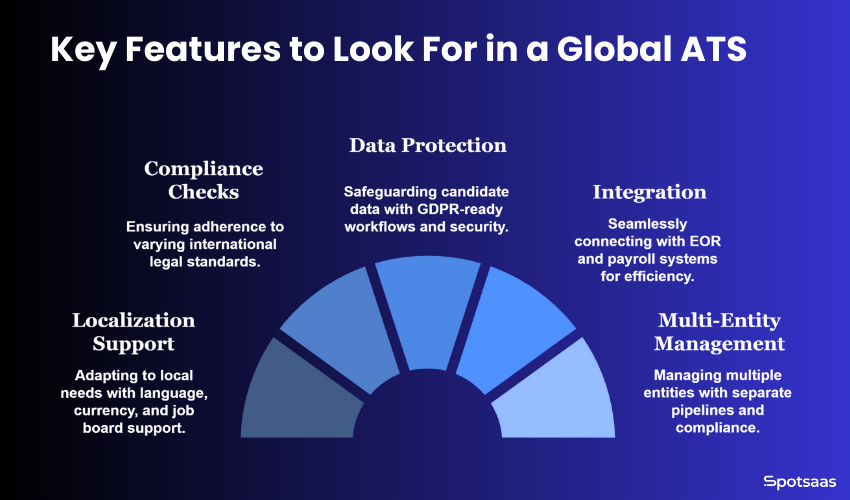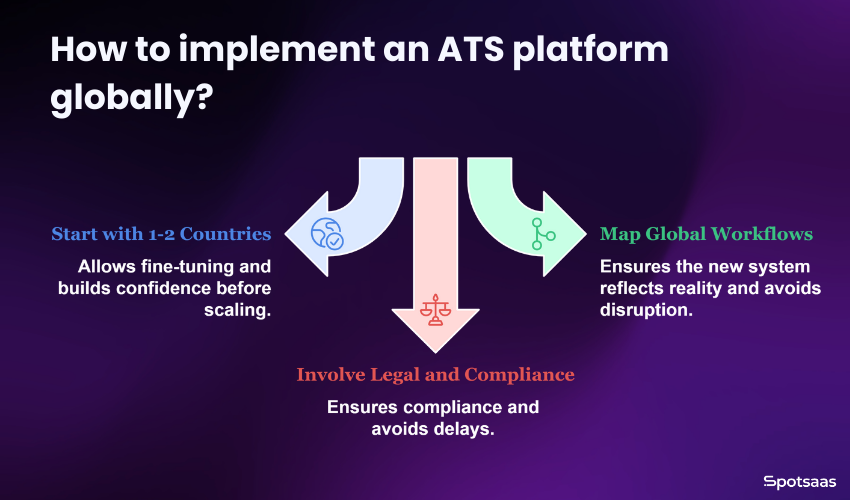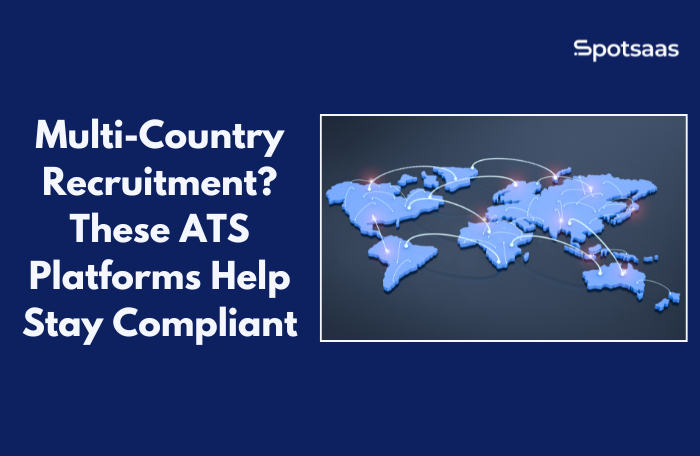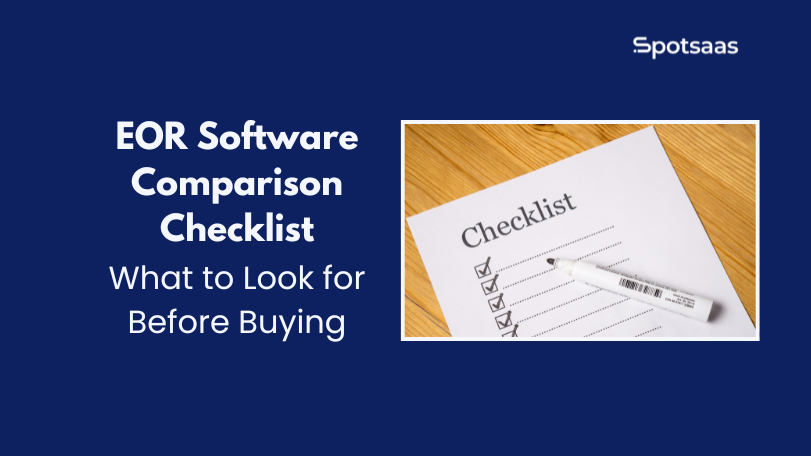Multi-country hiring isn’t as simple as posting a job and reviewing resumes. Each region comes with its own set of hiring regulations, data protection requirements, and payroll rules. Without the right tools, staying compliant can quickly become overwhelming. That’s where a global-ready Applicant Tracking System (ATS) helps—streamlining hiring workflows while adapting to local laws and practices.
What This Blog Includes
Before investing in a global-ready ATS, it’s important to know what to look for and how to make it work across regions. Here’s what you’ll find in this guide:
- A quick overview of what sets these platforms apart from standard applicant tracking systems.
- From contract localization to automated labor law checks, see what matters when hiring across borders.
- A breakdown of leading platforms built specifically for international hiring teams.
- Practical advice on choosing the right tool, getting internal buy-in, and rolling it out in phases.
What Is an ATS for Multi-Country Recruitment?
An ATS designed for multi-country recruitment goes beyond standard hiring features. It’s built to support teams that hire across borders by offering tools that align with local employment laws, cultural nuances, and operational differences.
These platforms typically include region-specific workflows, support for multiple languages and currencies, and built-in compliance safeguards to ensure every hire meets the legal standards of the respective country.
How a Multi-country ATS is different from a standard ATS?
| Feature | Multi-Country ATS | Standard ATS |
|---|---|---|
| Job Posting | Localized by language, currency, and region | Mostly limited to one country or language |
| Compliance | Built-in rules for global labor laws | Handles local compliance only |
| Time Zones | Automatic scheduling across time zones | Manual coordination required |
| Entity Support | Manages multiple legal entities | Designed for single business unit |
| Contract Templates | Country-specific offer letter options | Single default template |
| Candidate Experience | Localized forms and communication | Generic for all applicants |
| Best For | Global teams, fast-scaling companies | Local hiring, small teams |
- A standard ATS usually supports centralized hiring within one region or team.
It focuses on local job boards, internal workflows, and compliance specific to a single country or market. While efficient for domestic hiring, it lacks the flexibility needed for global expansion. - A multi-country ATS is built to adapt to different hiring practices, legal requirements, and cultural norms across countries. These systems recognize that every country may have its own labor laws, onboarding procedures, and documentation formats—and are designed to handle that complexity smoothly.
- It manages region-specific workflows, such as job postings in local languages and formats. Whether it’s formatting resumes for European roles or listing openings on country-specific job sites, a global ATS ensures candidates and hiring teams are aligned by region.
- The platform handles time zone differences, ensuring smooth collaboration between global teams. It can automate scheduling across time zones, coordinate interviews without delays, and keep communications in sync regardless of where recruiters or candidates are located.
- It supports the generation of country-specific offer letters and documentation that meet local compliance needs. Built-in templates and approval flows help teams issue contracts and onboarding materials that match legal standards in each hiring region—reducing compliance risk.
- Ideal for businesses with global expansion plans or those operating under multiple legal entities. A multi-country ATS allows companies to manage hiring across different subsidiaries, branches, or markets—without duplicating tools or processes for each region.
- Provides a unified dashboard to streamline international hiring without switching tools or platforms. From sourcing and screening to documentation and reporting, everything happens in one place—giving HR and talent teams greater visibility and control.
ATS platforms for multi-country hiring
Workable

Workable
- Spot Score 9.6
- Best For: Small to Mid-Sized Business
- Pricing: Starts from 169/month
Overview
Workable is designed for growing businesses that need a reliable, scalable solution for international hiring. It supports recruitment workflows in over 100 countries and offers built-in compliance tools that simplify legal alignment across jurisdictions. From job posting to onboarding, the platform streamlines every stage with clarity and flexibility.
Key Features
- Global job board syndication
- Role-based access with country-specific permissions
- GDPR and EEO compliance tools
- Automated offer letters with local templates
- Multi-language candidate portal
Pricing:
- Starter Plan: $169/month for up to 20 employees.
- Standard Plan: Pricing varies based on company size and needs.
- Free 15-day trial available.
Pros & Cons
| Pros | Cons |
|---|---|
| Intuitive user interface with minimal learning curve | Some customization features are only in higher-tier plans |
| Easily scalable for remote and international teams | Limited in-app analytics compared to more enterprise-level solutions |
| Built-in templates for contracts and legal compliance | |
| Strong integration ecosystem (HRIS, payroll, calendars) |
SmartRecruiters

Overview
SmartRecruiters is built for organizations that hire across regions and require a unified platform to manage global compliance. Its enterprise-grade capabilities, paired with user-friendly interfaces, make it a preferred choice for international teams. The platform ensures that every stage of hiring, from job requisition to onboarding, aligns with local employment standards.
Key Features
- Compliance-ready workflows for global hiring
- Country-specific hiring templates and offer letter formats
- Built-in GDPR and DEI (Diversity, Equity, Inclusion) support
- Multi-language career pages and applications
- Seamless integration with background check and legal tools
Pricing
SmartRecruiter’s pricing uses custom pricing based on company size and hiring volume.
Pros and Cons
| Pros | Cons |
|---|---|
| Ideal for large teams and multinational organizations | Higher learning curve for smaller teams |
| Custom workflows to match country-level requirements | Some advanced features may require technical setup or admin support |
| Strong reporting tools for compliance audits | |
| Supports collaboration across departments and locations |
Lever

Overview
Lever is a modern applicant tracking system that helps teams scale hiring across countries while staying aligned with regional laws. It combines applicant tracking with CRM capabilities, making it especially useful for companies that need to build and manage global talent pipelines.
Key Features
- GDPR-compliant data management
- Custom offer workflows per country
- Multi-language candidate communication
- Detailed audit trails for compliance monitoring
- Built-in reporting for DEI and legal metrics
Lever Pricing Overview
Lever offers custom pricing based on business size, hiring needs, and selected features. The pricing structure includes:
- LeverTRM: A full-suite talent acquisition solution that combines ATS and CRM features
- LeverTRM for Enterprise: A scalable solution for large companies with advanced analytics and integrations
- Lever Hire: A standalone applicant tracking system for businesses that need a streamlined recruiting solution
Companies can request a custom quote based on their hiring volume and workforce goals.
Pros and Cons
| Pros | Cons |
|---|---|
| Clean and intuitive interface for recruiters and hiring managers | May require third-party tools for payroll or onboarding |
| CRM features make it easy to nurture talent globally | Some setup effort needed for advanced customizations |
| Flexible workflows suited for distributed teams | |
| Transparent reporting and export-ready data for audits |
Greenhouse

Overview
Greenhouse is a structured hiring platform trusted by fast-growing companies and enterprises with international teams. It focuses heavily on process consistency and compliance, helping recruiters follow localized hiring practices while maintaining a high-quality candidate experience across borders.
Key Features
- Structured hiring workflows for multi-country operations
- GDPR and CCPA compliance settings built-in
- Regional offer letter templates and hiring kits
- Multi-language support for candidate communications
- Custom permissions for country-specific access control
Greenhouse Pricing Overview
Greenhouse offers custom pricing based on company size, hiring needs, and feature selection. The pricing structure typically includes:
- Essential Plan: Best for small teams with basic ATS features
- Advanced Plan: Includes automation tools, analytics, and integrations
- Enterprise Plan: Full-suite solution with AI-powered recruiting, compliance tools, and global hiring support
Businesses can request a custom quote based on their hiring requirements.
Pros and Cons
| Pros | Cons |
|---|---|
| Ideal for companies focused on process-driven hiring | Feature-rich dashboard may take time to fully utilize |
| Detailed reporting and compliance visibility | Advanced analytics may require training or support |
| Easily adapts to new regions with modular workflows | |
| Extensive integration library (HRIS, payroll, background checks) |
Key Features to Look For in a Global ATS

Localization Support
A global ATS should adapt to local needs without additional setup. This includes support for multiple languages, currencies, time zones, and region-specific job boards. Localization not only improves candidate experience but also ensures your hiring workflows stay culturally relevant. It’s especially important for companies hiring across regions with diverse candidate pools.
Built-in Compliance Checks
Compliance requirements vary drastically across countries. Look for an ATS that flags issues automatically—like contract terms that don’t meet local standards or missing labor clauses. These real-time checks help avoid legal oversights and keep your team aligned with regional hiring laws, even as requirements change.
Data Protection & Privacy
To stay legally sound, your ATS should offer features like GDPR-ready workflows, audit trails, and data residency controls. The ability to manage where candidate data is stored and how it’s processed ensures compliance with global privacy regulations. Strong data security also builds trust with candidates across markets.
Integration with EOR or Global Payroll
An effective global hiring setup often requires partnerships with Employer of Record (EOR) platforms or international payroll providers. Choose an ATS that integrates directly with these systems. This allows for smoother onboarding, faster contract generation, and automated compensation workflows—all within compliance boundaries.
Multi-Entity or Subsidiary Management
Hiring across different business units or countries? A global ATS should let you manage multiple legal entities from a single dashboard. This includes separating hiring pipelines, assigning local approvers, and maintaining compliance records per region. It simplifies oversight and ensures each entity meets its specific obligations.
Pros and Cons
| Pros | Considerations |
|---|---|
| ✔ Speeds up global hiring with automation | ✘ May require training for region-specific features |
| ✔ Reduces legal risk with compliance checks | ✘ Might not cover every country’s regulation out of the box |
| ✔ Integrates with EOR and payroll platforms | ✘ Some integrations may come at extra cost |
| ✔ Centralizes hiring across multiple entities | ✘ Managing permissions can get complex at scale |
| ✔ Improves candidate experience through localization | ✘ Translating and customizing content may require effort |
Real Use Cases
- Retail chains handling seasonal spikes
Large retailers with frequent seasonal hiring cycles use AI screening tools to quickly identify qualified candidates from thousands of applications—cutting time-to-fill by nearly 40%. - Tech startups scaling globally
Fast-growing startups rely on automated scheduling and global ATS features to hire across time zones without delays or bottlenecks, ensuring a smooth candidate experience. - Healthcare organizations streamlining credential checks
Hospitals and clinics use AI-driven compliance tools to verify certifications and licenses efficiently, helping them stay audit-ready while onboarding at scale. - Remote-first companies reducing candidate drop-off
Distributed teams benefit from AI-matching and smart nudges that keep top candidates engaged, reducing ghosting and improving offer acceptance rates.
Integration Scenarios
Choosing the right ATS isn’t just about features—it’s about how well the platform fits into the tools your team already uses. A well-integrated system saves time, reduces manual work, and keeps data flowing across every stage of the hiring journey. Here’s how global-ready ATS platforms typically work with other HR solutions:
| Integration Type | Purpose |
|---|---|
| Payroll System Sync | Auto-transfers offer and tax data to payroll for faster onboarding. |
| Calendar Integration | Simplifies interview scheduling across time zones with real-time syncing. |
| API Flexibility | Adapts workflows for region-specific needs like background checks or documents. |
Sync with Payroll Systems
Once a candidate accepts an offer, the next step is onboarding—and that’s where payroll integration becomes essential. Modern ATS tools can automatically pass data like salary, start date, tax details, and contract terms directly to your payroll system.
This removes duplication, reduces errors, and speeds up onboarding for cross-border hires, especially when handling different tax and benefits rules by region.
Calendar Tool Integration
Interview coordination across time zones can be one of the biggest slowdowns in international hiring. Many platforms offer built-in integrations with tools like Google Calendar, Microsoft Outlook, and Office 365.
This allows recruiters to view availability in real time, suggest optimal time slots, and send auto-reminders—without toggling between platforms or risking scheduling errors.
API Flexibility for Region-Specific Workflows
Every country has its own unique hiring flow. Whether it’s an extra layer of compliance approvals, background verification steps, or local document uploads, an open API allows your team to tailor the ATS to meet those needs.
Flexible API capabilities mean you can build integrations with local background check providers, country-specific document storage systems, or even internal HR dashboards for better oversight.
By choosing a platform that connects easily with your existing tools, you create a cohesive system that supports both efficiency and compliance—without adding more complexity to your stack.
Common Challenges & How These Platforms Help
Hiring internationally isn’t just about finding the right talent—it’s about doing it correctly, within legal frameworks, and without delays. Here’s how modern ATS platforms with AI and compliance capabilities solve these roadblocks.
| Challenge | Issue | Solution |
|---|---|---|
| Labor Law Gaps | Hard to keep up with country-specific rules. | Auto-guides ensure contracts stay compliant. |
| Docs Chaos | Missing or late ID and tax docs. | Smart flows request the right files by location. |
| Slow Approvals | Legal reviews delay hiring. | Instant templates reduce back-and-forth. |
Confusion Over Local Labor Laws
Labor laws vary dramatically from one country to another—covering everything from minimum wages and probation periods to termination rules and working hour limits. For teams unfamiliar with these nuances, it’s easy to misstep.
How the platform helps:
Many global ATS platforms are equipped with built-in rule engines that provide country-specific guidance as you build job offers or contracts. These tools automatically flag missing clauses, suggest compliant alternatives, and ensure that every step aligns with the local legal environment—reducing dependency on legal teams and avoiding costly misalignment.
Document Collection from Candidates
When hiring globally, collecting the right documents can feel chaotic. Tax IDs, visas, government forms, NDAs—requirements vary by location and role. Relying on email chains or spreadsheets quickly becomes unmanageable.
How the platform helps:
Leading platforms offer localized onboarding flows that adapt based on the candidate’s country. These guided workflows prompt applicants to upload the right documents and sign region-specific forms digitally. By streamlining this step, teams save time, avoid chasing paperwork, and ensure compliance before day one.
Delayed Hiring Due to Compliance Reviews
Waiting for legal teams to review each offer letter or contract—especially across regions—can hold up hiring, frustrate candidates, and cost you great talent.
How the platform helps:
AI-powered ATS platforms provide access to automated contract templates that are pre-reviewed and legally aligned with local standards. Recruiters can generate compliant documents instantly, personalize terms as needed, and send them out for signatures—all without lengthy back-and-forth with legal teams.
Implementation Tips
Rolling out an ATS platform across multiple countries can feel complex, but with the right approach, it becomes a strategic advantage rather than a logistical challenge. Here are key tips to guide a smooth and scalable implementation.

Start with 1–2 Countries Before Scaling
Begin by launching the platform in just one or two regions where hiring volume is high or processes are already somewhat standardized. This smaller rollout allows you to fine-tune workflows, identify any friction points, and build internal confidence before expanding globally. It’s better to get things right in one area than struggle with scale too early.
Map Out Your Existing Global Workflows
Before customizing the platform, take time to document how hiring currently happens in each region—who approves offers, how interviews are scheduled, what compliance steps are needed, and where delays typically occur. This upfront clarity helps you design workflows in the new system that reflect reality and avoid unnecessary disruption.
Involve Legal and Compliance Teams Early
One of the biggest risks in global hiring is non-compliance. By involving legal and compliance teams early in the tool selection and setup process, you ensure that templates, offer letters, data policies, and hiring stages meet regional requirements. Their input also helps avoid delays later during audits or reviews.
When these steps are in place, your global ATS implementation won’t just work—it’ll scale with your team’s needs and reduce hiring risk across borders.
Conclusion
Hiring across multiple countries comes with its own set of challenges—but with the right ATS in place, those challenges become manageable and even predictable. The goal isn’t just to stay compliant; it’s to build a hiring process that scales smoothly, respects regional requirements, and keeps candidate experience consistent everywhere.
Whether you’re hiring in two countries or twenty, choosing a platform that understands local rules, automates repetitive tasks, and simplifies documentation can make a significant difference. Focus on what matters most to your team: the countries you hire in, the volume you handle, and the level of compliance oversight you need.
With the right software partner, multi-country recruitment becomes less about risk—and more about readiness.
Frequently Asked Questions
What is a multi-country ATS?
An ATS built to support hiring across multiple countries with features like localization, compliance tools, and global workflows.
How does a global ATS help with compliance?
It includes rule engines, contract templates, and audit trails that align with country-specific labor laws.
Can these platforms integrate with payroll and EOR tools?
Yes, many global ATS platforms integrate directly with payroll providers and Employer of Record systems for seamless onboarding.
Is a global ATS suitable for startups?
Yes, especially for startups scaling across borders that need efficient, compliant hiring systems from the start.
Do these platforms support multi-language candidate experiences?
Absolutely—they offer multi-language portals, localized job postings, and region-specific communication templates.





